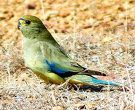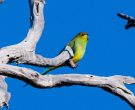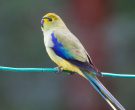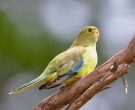Content
|
|---|
Description
20 to 21 cm. length and a weight between 44 and 61 g..
The Blue-winged Parrot (Neophema chrysostoma) has the crown olive green color with a yellow front wallwashing; blue front band (clearer on the back edge), arriving from the front towards the eyes (but not beyond); Lords bright yellow; coverts outpus and face Gris-Oliva. Upperparts olive green color without brightness.
Wing coverts blue, clearer in some feathers of the greater coverts Interior. Primaries black, with blue-violet edges in vane thin yellow margin and external; secondary internal with vane Green external, secondary average with blue in vane outer; tertiary olive green. Wing feathers blue. Top of the chest light green with yellow shading in the area of the belly and undertail- coverts. Upper, the tail is bluish grey, with the exception of the tips of the outer tail feathers, that are yellow.
The bill It is greyish-black with a pinkish lower jaw and the upper jaw with sharp edges.; irises dark brown; legs gris-rosado color.
The female it is duller than the male with the line that adorns the forecrown less developed.
It has the top of the crown olive green. The underparts they are tinged with pale green.
The young birds they lack the frontal band and most show a wing bar; the bill It is orange in very young birds.
- Sound of the Blue-winged Parrot
Habitat:
During the nesting season, the Blue-winged Parrot frequent eucalyptus plots.
starting winter, These birds change the habitat type, visiting the clear, orchards or similar locations. In addition to these common locations, they tend to move into thickets of acacia and lightly wooded grasslands. At this time of the year, the Blue-winged Parrot They also feel attracted by the arid plains with Salt plants (Atriplex) and for the coast and mountain Moors.
These colorful birds occasionally visit swamps, sand dunes along the coast and wetlands.
To the Blue-winged Parrot You can see them in pairs or in small groups, but in the off-season, form large meetings in the regions south of the coast, in partnership with the Crimson Rosella or more rarely with the Orange-bellied Parrot.
When feed, they are relatively accessible, flying into a nearby tree when bother them.
During the courtship, the male drops his wings, moves the head and regurgitates food for your future partner. By now, not explained clearly the migration. We know that birds from the south of the continent head north after breeding and the northern limit of this movement is in the south of Queensland. On the other hand, It is unclear whether all the population of the island of Tasmania It has to do with the migration that it crosses the bass strait.
Reproduction:
The nesting season extends from October to January. The nest It is usually a natural cavity in a large eucalyptus. Sometimes, However, found in a stump on a fence post or fallen log.
The female always makes the choice of the site. The Blue-winged Parrot They nest in colonies, sometimes several pairs are established in the same tree. The site can be used for several consecutive years.
The setting contains of 4 to 6 eggs, which are incubated for a period of 18 to 20 days. At birth, the chicks are altricial, and leave their place of birth to the 30 days after hatching. But, they stay with their parents for a short time before becoming independent.
Food:
The Blue-winged Parrot they feed mainly on grass seeds, and especially Danthonia What are the grass family? Poaceae. But, they often enter fields, where to dig the ground with their beaks to retrieve newly sown seeds.
Insects and invertebrates are probably part of their diet. Fruits and flowers represent a significant part of its menu.
Distribution:
During the breeding season (September to January) the birds are found below in 36 ° S, concentrating in the wetter parts of the southeast of Southern Australia, South of Victoria, and in Tasmania.
In winter they are, to a large extent, absent of Tasmania and are distributed much more North, in the southeast of Australia, reaching the South of Queensland (some 26 ° S, for example Thargomindah, Cunnamulla, Chinchilla), and extending westward to the East of Southern Australia, coming to the South of the eyre peninsula and spreading northward around the border of Queensland; They also extend to the East, to the Western parts of New South Wales (as well, from time to time, to the South of the coastal districts in summer).
It is not known if the continental population of the South is resident and birds of Tasmania they are migrant, flying over the Mainland farms to winter over North, or if the entire population moved northward in winter.
There are relatively few records of the King Islands and Flinders, which suggests that, Unlike in the Orange-bellied Parrot, most birds fly over Bass Strait directly to the mainland.
The Blue-winged Parrot are generally common in most open field types and are, probably, the most common parrot in Tasmania. where are reproduced to the South of Macquarie Harbour, on the West Coast and are found in the central region, provided that their habitat is suitable.
Flocks of up to 2.000 young birds they can form in the Northwest of Tasmania before the autumn migration.
The world's population is above the 20.000 birds.
Conservation:
• Current category of the Red List of the UICN: Least concern
• Population Trend: Stable
According to the Manual of the birds of the world (HBW), This species is not threatened globally. It is even common in the region of Melbourne and Tasmania.
The population is suspected to be stable in the apparent absence of any reduction or substantial threats.
According to Barry Talor, the world population would exceed 20.000 individuals.
"Blue-winged Parrot" in captivity:
The Blue-winged Parrot It, in general, less popular in aviculture as the Crimson Rosella, the Turquoise Parrot, the Scarlet-chested Parrot and the Bourke's Parrot, it's not really weird though.
Their behavior is relatively quiet with few movement needs. It is a bird that is easy to maintain, even for beginners. Your need to crack is almost non-existent and their need for bathroom depends on the individual. It is resistant to the European climate and, certainly, is not inferior to other species of neophemas. But, is susceptible to fog and cold damp, as we know it here in the fall and winter seasons.
The Blue-winged Parrot they seek food by digging in the Earth and are therefore vulnerable to parasitic infections.
According to sources, a Blue-winged Parrot lived during 21 years in captivity. In captivity, these animals have been able to play at the age of 2 years.
Alternative names:
– Blue-winged Parrot, Blue winged Parrot, Blue-banded Grass-Parakeet, Blue-banded Grass-Parrot, Blue-banded Parrot, Blue-winged Grass-Parakeet, Grass Parrot, Hobart Grass-Parrot (ingles).
– Perruche à bouche d’or, Perruche à ailes bleues, Vénuste à ailes bleues (French).
– Feinsittich (German).
– Periquito-de-asa-azul (Portuguese).
– Papagayo de Alas Azules, Periquito Crisóstomo (español).
scientific classification:
– Order: Psittaciformes
– Family: Psittaculidae
– Genus: Neophema
– Scientific name: Neophema chrysostoma
– Citation: (Kuhl, 1820)
– Protonimo: Psittacus chrysostomus
Images “Blue-winged Parrot”:
Videos "Blue-winged Parrot"
————————————————————————————————
“Blue-winged Parrot” (Neophema chrysostoma)
Sources:
– Avibase
– Parrots of the World – Forshaw Joseph M
– Parrots A Guide to the Parrots of the World – Tony Juniper & Mike Parr
– Birdlife
– Photos:
(1) – Blue-winged Parrot, Tasmania. Neophema Chrysostom By KeresH (Own work) [GFDL, CC-BY-SA-3.0 or CC BY-SA 2.5-2.0-1.0], via Wikimedia Commons
(2) – Blue-winged Parrot (Neophema chrysostoma), Mortimer Bay, Tasmania, Australia By JJ Harrison (jjharrison89@facebook.com) (Own work) [CC BY-SA 3.0], via Wikimedia Commons
(3) – Blue-winged Parrot (Neophema chrysostoma), Flagstaff Gully, Hobart, Tasmania, Australia By JJ Harrison (jjharrison89@facebook.com) (Own work) [CC BY-SA 3.0], via Wikimedia Commons
(4) – Blue-winged Parrot (Neophema chrysostoma) by Ron Knight – Flickr
(5) – Blue-winged Parrot, Tasmania. Neophema Chrysostom By KeresH (Own work) [GFDL, CC-BY-SA-3.0 or CC BY-SA 2.5-2.0-1.0], via Wikimedia Commons
– Sounds: nick talbot (Xeno-canto)






